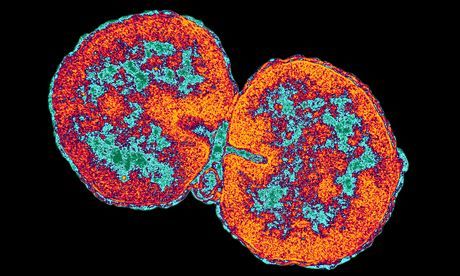
Diseases we thought were long gone, nothing to worry about, or easy to treat could come back with a vengeance, according to the recent World Health Organisation report on global antibiotic resistance. Concern at this serious threat to public health has been growing; complacency could result in a crisis with the potential to affect everyone, not just those in poor countries or without access to advanced healthcare. Already diseases that were treatable in the past, such as tuberculosis, are often fatal now, and others are moving in the same direction. And the really terrifying thing is that the problem is already with us: this is not science fiction, but contemporary reality. So what are some of the infections that could come back to haunt us?
Tuberculosis
TB ought to be treatable within six months once people are prescribed a course of drugs including the once potent antibiotics isoniazid and rifampicin. But today, resistance has emerged not only to these medicines, but to the wider range of pharmaceuticals used to treat the disease. This has led to the emergence of multi-drug-resistant TB, the still less treatable extensively drug-resistant TB (XDR-TB), and even to total drug-resistant TB, which has only officially been confirmed in India. Countries such as South Africa have run out of treatment options for many of their patients and are having to discharge them from hospital. Resistance to TB has reached a global scale with XDR-TB now reported in 92 countries.
Gonorrhoea
The sexually transmitted nature of this infection makes it something many are reluctant to talk about or admit to having. However, it's long been thought of as easily treatable and nothing much to fear. Once fixable with penicillin and tetracycline, the bacteria behind the disease have developed such high levels of resistance that there is only one drug left that can treat it. Even this antibiotic, ceftriaxone, is becoming less effective. With last-resort drugs losing their impact, this sexually transmitted infection (STI) could spread throughout the population.
Klebsiella
It's likely that you've never heard of this common bacterium, which can cause a wide range of conditions including pneumonia, urinary tract infections, septicaemia, meningitis and diarrhoea. It fits into a wider group of bacteria with the apt acronym of Eskape owing to their ability to avoid the effects of the antibiotics used against them. The acronym stands for the names of the bacterial group members: Enterococcus faecium; Staphylococcus aureus; Klebsiella pneumoniae; Acinetobacter baumannii; Pseudomonas aeruginosa; and Enterobacter. Klebsiella and the rest of this group are increasingly being acquired in hospitals. While we fear MRSA, it is in fact a declining threat in hospitals; at the same time Eskape pathogens are causing more and more problems. As the WHO report highlighted, routine hospital visits or treatments could result in these previously treatable bacteria having fatal consequences.
Typhoid
Routine vaccination against typhoid means it's not a disease that is often on our radar, and when it is it's rarely something we fear. However, the disease still affects 21.5 million people each year in the developing world, and globalisation means travel to potential sources of infection is more common. As a result, more than 5,000 people in the US are infected annually after eating contaminated food and drink. Typhoid fever, which is caused by the bacterium salmonella typhi, is treated with antibiotics, but resistance to multiple antibiotics is increasing. Reduced susceptibility to the fluoroquinolone class of drugs and the emergence of multi-drug-resistance has complicated the treatment of infections, especially those acquired in south Asia. Since a vaccination exists, the key is to receive this before you get on to a plane. Otherwise, consuming that innocent-looking vegetable on a trip to Thailand could leave you with a potentially fatal fever topping 100F.
Syphillis and Diphtheria
Although resistance to these diseases is yet to emerge, public awareness of them has reduced as a result of effective treatments. But in an era of resistance there is always the potential for them to return as a serious public health threat. Although rates of syphilis are low, they have been increasing in the UK since 1997. This STI is currently treated by a single injection with penicillin, but resistance to this antibiotic has developed in other diseases. Imagine the impact if it happened again. The fever and chills of diphtheria are mainly prevalent in the developing world, but with travellers contracting typhoid even though a vaccine is available, the same could happen with diphtheria.
So what can be done?
Antibiotic resistance is a problem we can all help to reduce. Good hand hygiene when visiting people in hospital helps. Only taking antibiotics when prescribed by a doctor is crucial; as is always completing a full course if you do have to take them. In addition, doctors themselves should only be prescribing these medicines when patients truly need them. These may be small things, but if we all do them it will have an impact and maybe prevent a future where treatable diseases become fatal once more.



Comment: Learn more about the growing concerns over antibiotic resistance:
The abuse of antibiotics and the rise of 'super bugs'
Antibiotics Prove Powerless as Super-Germs Spread
'Devastating' implications of drug-resistant superbugs now a reality
Scientists Fear Antibiotics are Perpetuating Diseases Impossible to Treat
Chief Scientist: Act now or live through deadly post antibiotic resistance era
The following article is a must read: Dr. Brad Spellberg: Antibiotic resistance is "Everyone's Fault"